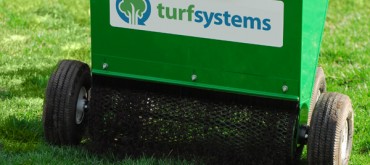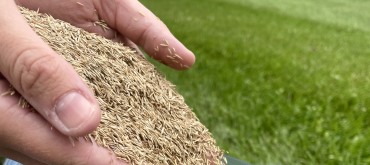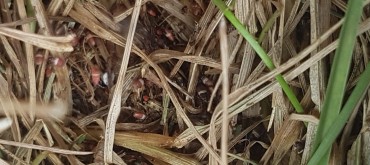Lawn Care is typically a spring and summer priority, no? The ironic truth is that fall and early winter are the most crucial time periods for your lawn as the grass which grows late in the season is the foundation for your turf next spring.
Applying Fertilizer
It is important to prepare the lawn with winter fertilizer. Turf System’s Dormant Winter Application is a slow release granular fertilizer that is designed to help your lawn recover quickly the following spring. This specialized fertilizer breaks down slowly to continuously provide the nutrients that are otherwise not available to your lawn during the snowy winter months.
Our Benefits of Raking blog explains how too much organic matter can be damaging to lawns. However, applying a thin layer of compost can provide several benefits. This compost layer can protect your root system from cooler temperatures, frost and snow. The deeper layers of soil will be protected from the heightened risk of freezing during the cold winter months.
Adjusting Mowing Height and Lawn Mower
In areas where snow cover is not guaranteed all winter, it is advised to keep your mowing height in the late fall the same as the rest of the year. If however, you live in an area prone to a lot of snow cover for long periods of time, it is advised to lower your mowing height to approximately 2”-2 ½”. A slightly shorter turf length will protect any new growth that sprouted at the end of the lawn care season. A longer blade has the potential to fracture under pressure and will not survive the winter, except when there is no snow cover, where the longer leaf can help protect and insulate the exposed surfaces.
Before winterizing your lawn mower for the season, add fuel stabilizer for safe storage. Also, consider taking the blades off your lawn mower to have them sharpened in order to be fully prepared for spring.
Minimizing Traffic
It is recommended to minimize traffic on your lawn once covered by heavy snow. To avoid brown patches, take the time to remove all objects from your lawn prior to snowfall. Remember, turf grass is more vulnerable when frozen under snow cover, subsequently, the ability for it to breathe is vital. Ice buildup under snow can also be a significant problem when increased traffic or ice rinks traps the lawns ability to breath, sometimes causing snow mold damage in the spring.
Avoid Water Build Up
It is important to safeguard against water build up during the winter months. Once the snow melts, water run-off can remove the valuable soil from your lawn. Poor soil drainage will hinder the overall health of your lawn. This may seem more difficult to manage as it is dependent on the volume of snowfall, but there are proactive steps you can implement. Soil drainage can be improved by utilizing proper water techniques explained further in Watering Tips.
Proper lawn care practices should be a priority throughout the year, no matter the season. It is important to note that your lawn requires different maintenance strategies throughout the year as the surrounding environment changes. Although you may not see much of your lawn, winter lawn maintenance is still very much an important element to a healthy “Turn On Your Lawn”®.





